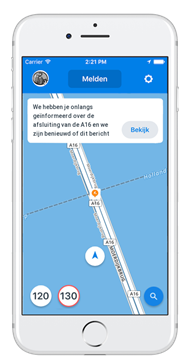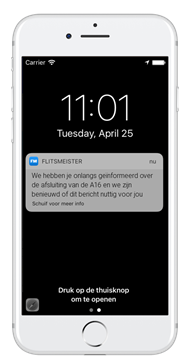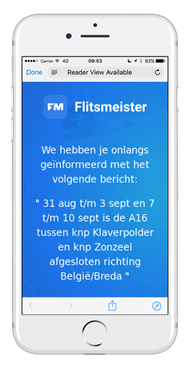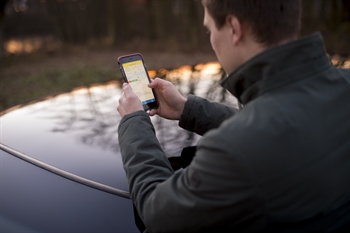Fact sheet In-app notifications
Also known to many people as push messages, in-app notifications are messages via smartphone apps that inform motorists about disruptions on their routes prior to and during road works.
This measure uses a group of existing app users. Road users who are running the app and are driving past a location with a virtual pin will receive a notification on their smartphone at the end of their trip. The location of virtual pins can be chosen in consultation with the market party. This often concerns the road where work will take place and the surrounding roads. The notification contains information about the (expected) disruption. This method of informing people strengthens the quality of information provision and thus contributes to reducing disruption.
The use of in-app notifications has a lot of potential. So far, experience has mainly been gained with notifications of closures and projects via the Flitsmeister app, including projects at Schiphol-Amsterdam-Almere, on the A12/A50 route and within the Variable Maintenance Contract (VOC) in the south of the Netherlands. The content of a notification usually consists of a map indicating the road, a very concise text (location and dates of the work) and a link to more information (e.g. the project page). After the agreed period in which notifications are sent, the client receives a report with the number of messages sent, unique users and the click-through percentage. Via Flitsmeister, it is also possible to carry out an effect measurement by means of a short survey about the received message. These effect measurements provide insight into the effectiveness of the measure.



A few examples of typical in-app notifications received by users
Accessibility effects
In 2018 and 2019, a number of road closures were notified via the Flitsmeister app, to which an effect measurement (fed with results from short surveys) was linked. When deploying location-based in-app notifications via the Flitsmeister app, between 20,000 and 90,000 unique users were reached (see table below), depending on the duration and location of the deployment (and the number of road users at that location) and the number of app users. Flitsmeister is the most widely used travel information app for 5.8% of Dutch motorists.
The various effect measurements show that with Flitsmeister in-app notifications, an average of 61% of the respondents did not know about the closure before seeing the notification. This percentage was lower when the app was deployed for a week-long closure, when more communication had already been deployed. The notifications contribute to better awareness of the work.
On average, 48% of the respondents modified their trip by avoiding the area around the closure, by choosing a different route, or by using public transport or bicycle. This percentage was higher in the case of a week-long closure, perhaps because making the trip was more necessary and urgent for a weekday road user than for a weekend road user. On average, only 0.5% of respondents modified their trip by opting for another means of transport: public transport or bicycle. So in these cases, hardly any motorists decided to use public transport or bicycle.
| number of unique reached users with the deployment of notifications | % of unique users who clicked through to the project website for more information | % of respondents in the effect measurement1 that saw the message | % who did not yet know about the closure (of all respondents to this ques-tion in the effect meas-urement) | % that modified their trip based on the message (of all respondents to this question in the effect measurement) | |
|---|---|---|---|---|---|
| A58 De Stok-Princeville | 30917 | 7.0% | 89.8% | 58.5% | 48.9% |
| A73 towards Maastricht Roermond-Vonderen2 | 21144 | 6.8% | 92.9% | 44.8% | 65.5% |
| A27 towards Breda Gorinchem-Hooipolder | 57836 | 6.7% | 77.5% | 73.2% | 33.4% |
| A16 Klaverpolder-Zonzeel | 54281 | 8.5% | 88.0% | 69.0% | 43.1% |
| A2/N2/A67 intersection Leenderheide | 25646 | 7.9% | 78.5% | 55.3% | 46.2% |
| A67 Zaarderheiken-Asten | 19817 | 6.9% | 87.0% | 60.1% | 55.6% |
| A2 intersection Het Vonderen-Nederweert | 22833 | 14.8% | 71.8% | 61.3% | 45.3% |
| A6 Almere Stad-intersection Almere | 89680 | 7.2% | 88.6% | 66.8% | 46.1% |
| Average | 8.2% | 84.3% | 61.1% | 48.0% |
1 On average, about 25% of unique users were approached as respondents for the effect measurement and the response rate was around 4% on average.
2 During this deployment, there was a week-long closure (during a holiday period).
There is no information about the times at which the surveyed road users travelled, so effects on rush-hour avoidance using in-app notifications are not known. Moreover, so far in-app notifications have mainly been used for weekend closures (and not during peak periods on weekdays).
Long-term effects
The measure is mainly used for temporary road works and therefore focuses on short-term effects. It is not known whether users who modified their behaviour in response to the messages maintained this behaviour in the long term. Many of the respondents stated that they avoided the area around the closure. Because this behaviour is specific to week/weekend disruptions, it is likely that road users will return to the 'old' route after the closure.
Sustainability effects
It is difficult to say anything about the direct effects on sustainability. The effect measurements for Flitsmeister show that road users adjust their behaviour, but how much exactly is not clear.
Variables affecting effects
We now know that location-based in-app notifications have added value, both in the announcement of closures and in limiting disruptions on diversion routes during closures. The effect measurements for Flitsmeister show that about half of the respondents modified their trip. However, we now only know the effects of the measure on Flitsmeister users. It may be worth using notifications from multiple apps side by side, in order to reach other (and larger) target groups. For example, it is also possible to use the travel information app Waze notifications (a so-called 'take-over') and inform road users who drive past a virtual pin about closures.
The main variables that affect the effects of location-based app notifications are:
- the location of the disruption/closures and the possible alternatives (e.g. public transport options or a different route)
- the number of road users on the route
- the number of users of the specific travel information app
- the extent to which the app users are representative of the average road user
- the way the message is conveyed. It is important to clearly state that the road is closed, that this causes major disruption, and advise road users to stay away. This has more effect than just indicating a possible disruption
- the image of the smartphone app. The trust that road users have in the app affects the results of alerts via app notifications
Costs
Currently, the cost of deploying a 'location-based alert' campaign via Flitsmeister is about €4,500 (including VAT) per 7-day campaign, depending on the location of the pins. The cost of an effect measurement is €500. Collaboration between government and service providers is in full swing. It is therefore wise to be well informed about any agreements with service providers prior to the deployment of this measure.
Sources consulted
- Monitoring wegverkeergerelateerde informatiediensten en rijtaakondersteunende systemen 2018 (Rijkswaterstaat, 2019)
- Reports of Flitsmeister effect measurements for campaigns on: A58 - De Stok - Princeville, A73 towards Maastricht Roermond - Vonderen, A27 towards Breda Gorinchem - Hooipolder, A16 - Klaverpolder - Zonzeel, A2/N2/A67 Leenderheide intersection, A67 Zaarderheiken – Asten, A2 Het Vonderen intersection – Nederweert, A6 Almere Stad - Almere intersection
- Case Study Flitsmeister push messages (SAA)(Rijkswaterstaat, 2017)

